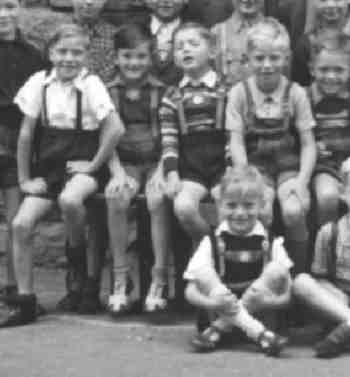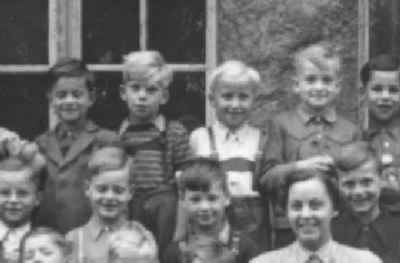
Figure 1.--This enlargement shows the large number of younger boys wearing either suspender shorts or leather lederhosen. Notice the one boy wearing school sandals and white kneesocks.


Figure 1.--This enlargement shows the large number of younger boys wearing either suspender shorts or leather lederhosen. Notice the one boy wearing school sandals and white kneesocks. |
Some of the clothing worn in German elementary schools during the Third Reich are discussed below. Boys wore a wide range of clothes. Little information is currently available on caps. During the War years (1939-45) military-styled caps became increasingly common. Some younger boys might wear sailor caps. Most school portraits, however, show the boys without their caps. Some boys dressed formally in suits of various description. Other boys dressed casually in sweaters and shirts. Boys wear a wide-variety of collared shirts. Most of the boys look to be wearing collared shirts. We see boys wearing both white and colored shirts. Patterned shirts were not very common. We do not see very many boys wearing checked shirts. Most boys in primary school wore short pants, some with kneesocks and others with long stockings. Quite a few boys wore suspender shorts. Lederhosen were also common, but still regional--concentrated in Bavaria and southern Germany. Boys during the summer mostly wear ankle socks. A few wear kneesocks, both dark colored, patterned and white kneesocks During the winter kneesocks are even more common. Some boys wear long stockings with shorts. Older boys might wear long pants thus the type of socks is not always apparent. The fashion of rolling down ones kneesocks which became fashionable in the late 1940s is not yet seen here. Boys wore a variety of shoes. We see many boys wearing heavy high-top shoes. Tennis (canvas shoes) are rare. During the summer many boys wear English-style school sandals. Most are the "T"-strap stle. A few boys wears the single-bar style, like strap shoes. We do not note open-toe sandals which became popular after the War. One common possession of many German school boys was a leather school satchel.
Little information is currently available on caps. During the War years (1939-45) military-styled caps became increasingly common. Some younger boys might wear sailor caps. Most school portraits, however, show the boys without their caps.
Few elementary-age boys wore jackets to school, at least suit jackets. We note some boys wearing suits for their first day of school portraits, but we think this the children often dressed up for the first day and suits were less common for ordinary school dress by the 1930s. There are, however, usually a few boys that wear suit jackets in many school portaitss. A few, especially in Bavaria wear folk-styled jackets.
Boys wear a wide-variety of collared shirts. Most of the boys look to be wearing collared shirts. We see boys wearing both white and colored shirts. Patterned shirts were not very common. We do not see very many boys wearing checked shirts. These shirs with Lederhosen became very common after the Ear. A few boys wore horizontal stripes. Elementary boys usually did not wear ties, although we see some in many class portraits.. We also see a few younger boys with bows, especially in the early 30s.
Sweaters were commonly worn by German school boys. Several styles were popular, especially pullover sweaters. We see both sleeveless sweaters and others with sleeves. Boys wore both long sleeve and sleeveless sweaters. We also note both solid color sweaters as well as some with patterns.
Elementary boys mostly wore short pants. Younger boys often wore suspender shorts. Lederhosen were also very common, although very regional. We do not know if suspender shorts were also regional. Some older elementary boys might wear long pants, but this was mostly during the colder winter months. Long pants became more common during the 1940s, but most boys still wore shorts. Some older boys wore knickers, but it was rare for younger boys in primary schoo; to wear them.

Figure 2.--None of these younger boys appear to be wearing ties and jackets are rare. Suspender shorts or lederhosen, however, are very common. |
Boys during the summer mostly wear ankle socks. A few wear kneesocks, both dark colored, patterned and white kneesocks During the winter kneesocks are even more common. Some boys wear long stockings with shorts. Older boys might wear long pants thus the type of socks is not always apparent. The fashion of rolling down ones kneesocks which became fashionable in the late 1940s is not yet seen here.
Boys wore a variety of shoes. We see many boys wearing heavy high-top shoes. Tennis (canvas shoes) are rare. During the summer many boys wear English-style school sandals. Most are the "T"-strap stle. A few boys wears the single-bar style, like strap shoes. We do not note open-toe sandals which became popular after the War.
One common possession of many German school boys was a leather school satchel. The boys do not generally wear their satchels for school portraits, but they do often wear them in their First Day portraits.
Related Chronolgy Pages in the Boys' Historical Web Site
[Main Chronology Page]
[The 1910s]
[The 1920s]
[The 1930s]
[The 1940s]
Navigate the German school pages
[Main NAZI primary school page]
[Main NAZI education page]
[Main school uniform national page]
[Main German school uniform page]
[Imperial Germany]
[Weimar Republic]
[NAZI era]
[Post-war Years]
[Modern Germany]
Navigate the Relate Boys Historical Clothing Style Pages
[Main country page]
[Long pants suits]
[Short pants suits]
[Lederhosen]
[Kneesocks]
[Eton suits]
[Jacket and trousers]
[Blazer
[School sandals]
Navigate the Boys' Historical Clothing Web Page
[Introduction]
[Activities]
[Biographies]
[Chronology]
[Clothing styles]
[Countries]
[Bibliographies]
[Contributions]
[Essays]
[FAQs]
[Glossaries]
[Satellites]
[Tools]
[Boys' Clothing Home]
